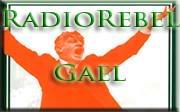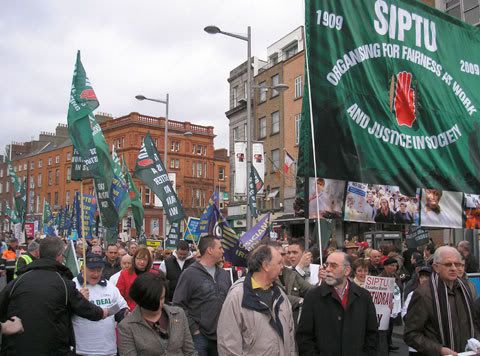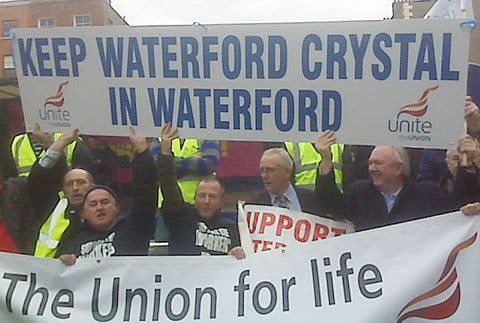The demonstration set off early to accommodate the swelling numbers—the Irish Republic only has a population of four million. An equivalent demonstration in the United States would have amassed several millions.
The source of workers anger is rooted in the massive economic crisis now gripping Ireland and the efforts of the coalition government of Taoiseach Brian Cowen of Fianna Fail, the Green Party and the Progressive Democrats. Ireland has lost its previous reputation as the “Celtic Tiger” economy spectacularly. It is now regarded as the economy most likely to follow Iceland into bankruptcy, after the collapse of a housing and speculative finance boom and the recent decision of the government to bail out the banks amidst ongoing accusations of nepotism and fraud on a massive scale.
Cowen has said that Ireland’s economy may shrink by 10 percent by 2010, with a budget deficit of 11 percent of gross domestic product this year. This has led to apocalyptic warnings by financial commentators, with Simon Johnson writing in the Times on February 15, “My point today is simple: a key warning sign just moved from orange to red.
”
Writing in the Irish Times economist Morgan Kelly wrote that the government had nationalised Anglo Irish, recapitalised AIB and Bank of Ireland without even being fully aware of the extent of their possible liabilities.
He warned, “The ability of the State to continue funding itself ultimately depends on the size of these bad debts. If they are of the order of €10–€20 billion, we will survive. If they are of the order of €50-€60 billion, we are sunk.
”
As to the impact on working people, he continued, “We could expect cuts of one-quarter to one-third in public sector wages and social welfare benefits, and draconian tax rises to bring the deficit back to around 5 percent of national income in two years.
”
The situation is already grim. In 2008 unemployment doubled to 8.3 percent, mainly due to the collapse in construction. With the rest of the economy now being hit, it could spiral beyond 500,000. This has prompted the government to make cuts of €5 billion, as well as savings measures such as the pension levy that is equivalent to a €1.4 billion pay cut. Pension deductions are to increase by three percent for those earning just €15,000, rising to 6.4 percent for someone on €35,000 and topping at 9.6 percent for the few earning €300,000. The Teachers Union of Ireland (TUI) said that the levy would bring total contributions to between 22 percent and 27 percent of the income of public service workers.
There is also a pay freeze next year and various other cuts. Much more will be needed. Ireland’s total structural deficit this year according to the European Commission is about €14 billion, which leaves a deficit of €9 billion to be clawed out of the working class. That is why the government responded to the protest by insisting that, though painful, its measures were “both necessary and fair” in the face of what it said was the most "profound global economic crisis in seventy years".
Saturday’s protest was described by the Times newspaper as “a swollen river of anger”. That it certainly was, on the part of the tens of thousands taking part. But the protest was called by the Irish Congress of Trade Unions and its motives and concerns are directly opposed to those of the working people the unions purport to represent.
The primary concern of the trade unions is to be seen to stand in opposition to the government. Without doing so, then there is a very real danger of the widespread opposition amongst workers getting out of control. The Waterford occupation is one manifestation of this danger. Already the unions have been forced to call a one day protest strike affecting 13,000 low-paid members of the Civil and Public Sector Workers Union on Thursday. Votes are being held for industrial action by 10,000 members of the Public Service Executive Union, 4,00 craft workers, as well as health and education workers.
The scale and breadth of opposition to the government was indicated by the presence on the demonstration of organisations representing both the army and, in the shape of the Garda Representative Association, the police.
Members of the national executive of the soldiers’ representative body, PDforra, were on the protest. PDforra General Secretary, Gerry Rooney told the Irish Times that “ordinary members” of the Defence Forces were angry that they were being “singled out to pay a pension levy when others, some of whom are very highly paid, are making no contribution to help resolve the poor budgetary situation”.
The Irish Times goes on to describe events that pose nothing less than a crisis of rule for the government. It states, “The decision of PDforra earlier this month to demand assurances that it would not be used to break public servants’ strikes has caused considerable disquiet among senior officers. The Army Chief of Staff, Dermot Earley, has already made it clear to PDforra representatives that the Defence Forces will ‘do its duty’ if asked by the Government. However, it is now understood that senior officers below Lieut Gen Earley have equally spoken to the men and women under their command about their responsibilities under the law.
”
The response of the ICTU is to offer to continue to police social discontent and to impose the attacks made necessary by the economic tsunami engulfing Ireland. The ICTU has collaborated with successive governments and the employers in various tripartite arrangements. It now complains that its offer to remain as one of the “social partners” has been sabotaged by Fianna Fail’s intransigence. It would be more correct to state that the onset of the economic crisis meant that the union leadership balked over the scale of the attacks they were being asked to impose.
According to the ICTU’s own account, on January 28, “Congress, Government and the employers settled on an outline Framework Agreement, which was to provide a basis for more detailed discussions on a National Recovery Plan.” But “Government failed to follow through on this commitment” because of “a narrow focus on the public finances--without seeking a contribution from the wealthy.
”
In one online report of the breakdown, Civil and Public Services Union executive member Terry Kelleher is said to have admitted that the CPSU General Secretary (Blair Horan) “who was at the talks… claimed that when the proposed 10% pay cut was put on the table part of the ICTU delegation proposed the 'pensions levy' as being more sellable. It was only as the specific figures became clear that Jack O'Connor of SIPTU and others pulled the rug on the deal.
”
The ICTU has published a 10 point plan for national recovery, “There is a better, Fairer way”, outlining initiatives that make a show of the rich “sharing the pain” such as a 48 percent rate of tax on the highest earners and a levy on second homes. They have also declared that Saturday’s protest would be the “first step in a rolling campaign of action.
”
Such militant statements count for very little when measured against the actual record of the ICTU and its affiliated unions in suppressing strikes and colluding with the government and the employers.
Addressing the rally at the end of O’Connell Street, ICTU President Patricia McKeown and General Secretary David Begg were clear in their understanding of the gravity of the crisis facing Ireland. The world as we have known it for the past 30 years, of economic plenty, passed away with the bankruptcy of Lehman Brothers, said Begg. An entire system had failed, he went on. But he and McKeown also made clear that this was supposed to refer only to “Casino Capitalism” and all that was needed was a more long-term view and a degree of social planning.
It was, said McKeown, necessary for workers to demonstrate the power they hold: on the streets, through industrial action, but above all at the ballot box by denying a vote to Fianna Fail. The ICTU makes this threat in order to secure its place in any resumed negotiations with Cowen government. But if this proves impossible and the movement against the government continues to escalate, then a fallback position is a working arrangement with the main opposition parties. This obviously includes the nominal left such as Labour and Sinn Fein, who both had substantial delegations on Saturday’s demonstration, but also the other main party of big business Fine Gail, which was in a ruling coalition with Labour until 2007. Fine Gael leader Enda Kenny has called for an early general election, stating that “I am prepared to lead the country out of this vacuum with a new mandate in a new direction," and the call has been echoed by Sinn Fein.
It is a measure of the discontent amongst workers towards the trade unions that the end of the demonstration, even while loudspeakers were braying out songs such as “You don’t get me, I’m part of the union”, “Power to the people” and “For the times, they are a changin’”, as if it were still the 1970s, saw the majority drift away as soon as they arrived. The union bureaucrats were left talking to themselves and the various “left” groups that are demanding nothing from them other than a one day national protest strike.
http://www.wsws.org/articles/2009/feb2009/dubl-f23.shtml






